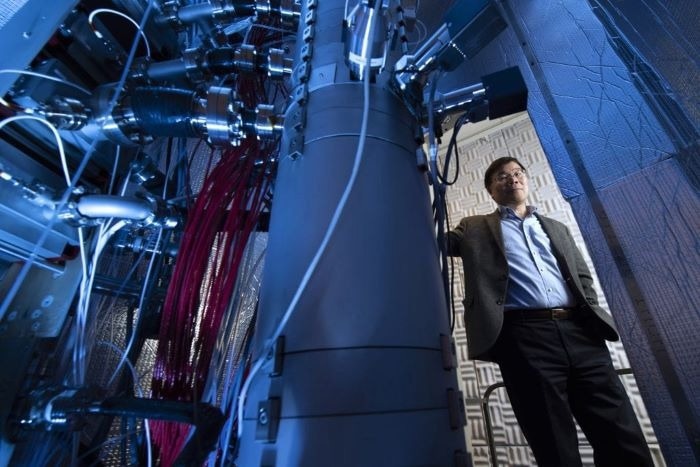Reviewed by Lexie CornerDec 6 2024
Researchers at the University of California, Irvine, have identified the atomic-scale mechanisms that improve superconductivity in an iron-based material. The study was published in Nature.
 Xiaoqing Pan, UC Irvine Distinguished Professor of Materials Science and Engineering as well as physics and astronomy, Henry Samueli Endowed Chair in Engineering, and Director of the Irvine Materials Research Institute, displays IMRI equipment that allowed his team to image atom vibrations at the interface between a superconductor and a substrate. The research, published recently in Nature, provides an atomic-scale understanding of what enhances superconductivity in advanced materials. Steve Zylius/UC Irvine
Xiaoqing Pan, UC Irvine Distinguished Professor of Materials Science and Engineering as well as physics and astronomy, Henry Samueli Endowed Chair in Engineering, and Director of the Irvine Materials Research Institute, displays IMRI equipment that allowed his team to image atom vibrations at the interface between a superconductor and a substrate. The research, published recently in Nature, provides an atomic-scale understanding of what enhances superconductivity in advanced materials. Steve Zylius/UC Irvine
Utilizing advanced spectroscopy instruments at the UC Irvine Materials Research Institute, the team was able to capture images of atomic vibrations and observe new phonons—quasiparticles responsible for carrying thermal energy—at the interface of an iron selenide (FeSe) ultrathin film on a strontium titanate (STO) substrate.
Primarily emerging from the out-of-plane vibrations of oxygen atoms at the interface and in apical oxygens in STO, these phonons couple with electrons due to the spatial overlap of electron and phonon wave functions at the interface. This strong electron-phonon coupling provides a mechanism for the enhancement of superconductivity transition temperature in ultrathin FeSe.
Xiaoqing Pan, Study Lead Author and Distinguished Professor, Materials Science and Engineering, University of California, Irvine
Xiaoqing Pan is also the Henry Samueli Endowed Chair in Engineering and IMRI Director.
The scientists discovered that FeSe has a superconductivity transition temperature of 65 Kelvin, approximately –340 ºF, making it the highest-temperature superconductor in its category. They observed a strong correlation between electron-phonon coupling and the uniformity of the FeSe/STO interface, noting that greater homogeneity results in a higher temperature at which superconductivity is achieved.
“Our vibrational spectroscopy approach enabled us to achieve highly detailed imaging of the vibrations at the superconducting material’s interface with its substrate. The observed variation in the interlayer spacing correlates with the superconducting gap, which demonstrates the crucial role of spacing in electron-phonon coupling strength and superconductivity,” said Pan, who holds a joint appointment in the UC Irvine Department of Physics & Astronomy.
The ultrahigh spatial and energy resolutions of state-of-the-art instruments at IRMI provide exceptional experimental data for theoretical analysis. This collaboration between theoretical simulations and experimental observations allows for precise identification of individual atomic contributions to the enhancement of the superconducting transition temperature, deepening our understanding of superconductivity at heterogeneous interfaces.
Ruqian Wu, Study Co-Author and Distinguished Professor, Physics and Astronomy, University of California, Irvine
Pan stated that the team's findings represent a significant advancement toward the scalable fabrication and application of superconductors in various fields, including quantum computing, magnetic levitation for mass transportation, and advanced medical diagnostic and treatment technologies.
In addition to collaborating with UC Irvine colleagues, Pan worked with researchers from Uppsala University in Sweden, Princeton University, the Beijing National Laboratory for Condensed Matter Physics, and the Institute of Physics at the Chinese Academy of Sciences. The project was supported by the US Department of Energy’s Office of Basic Energy Sciences, Division of Materials Sciences and Engineering.
Journal Reference:
Yang, H., et al. (2024) Phonon modes and electron–phonon coupling at the FeSe/SrTiO3 interface. Nature. doi.org/10.1038/s41586-024-08118-0.